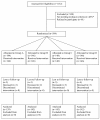Mujer Mas Segura (Safer Women): a combination prevention intervention to reduce sexual and injection risks among female sex workers who inject drugs
- PMID: 22891807
- PMCID: PMC3490986
- DOI: 10.1186/1471-2458-12-653
Mujer Mas Segura (Safer Women): a combination prevention intervention to reduce sexual and injection risks among female sex workers who inject drugs
Abstract
Background: Female sex workers who inject drugs (FSW-IDUs) are at risk of acquiring HIV, sexually transmitted infections (STI) and blood-borne infections through unprotected sex and sharing injection equipment. We conducted a 2×2 factorial randomized controlled trial to evaluate combination interventions to simultaneously reduce sexual and injection risks among FSW-IDUs in Tijuana and Ciudad Juarez, Mexico.
Methods/design: FSW-IDUs ≥18 years reporting sharing injection equipment and unprotected sex with clients within the last month were randomized to one of four conditions based on an a priori randomization schedule, blinding interviewer/counselors to assignment. Due to the extreme vulnerability of this population, we did not include a control group that would deny some women access to preventive information. All women received similar information regardless of group allocation; the difference was in the way the information was delivered and the extent to which women had an interactive role. Each condition was a single 60-minute session, including either an interactive or didactic version of an injection risk intervention and sexual risk intervention. Women underwent interviewer-administered surveys and testing for HIV, syphilis, gonorrhea, Chlamydia, and Trichomonas at baseline and quarterly for 12 months. Combined HIV/STI incidence will be the primary outcome. Secondary outcomes are proportionate reductions in sharing of injection equipment and unprotected sex with clients.
Discussion: Of 1,132 women, 548 (48.4%) were excluded (88.9% were ineligible; 11.1% refused to participate or did not return); 584 eligible women enrolled (284 in Tijuana; 300 in Ciudad Juarez). All 584 participants completed the baseline interview, provided biological samples and were randomized to one of the four groups. During follow-up, 17 participants (2.9%) were lost to follow-up, of whom 10 (58.8%) had died, leaving 567 participants for analysis. This study appears to be the first intervention to attempt to simultaneously reduce injection and sexual risk behaviors among FSW-IDUs. The factorial design will permit analysis to determine whether the combination of the two interactive interventions and/or its respective components are effective in reducing injection and/or sexual risks, which will have direct, tangible policy implications for Mexico and potentially other resource-poor countries.
Trial registration: NCT00840658.
Figures
Similar articles
-
Reductions in HIV/STI incidence and sharing of injection equipment among female sex workers who inject drugs: results from a randomized controlled trial.PLoS One. 2013 Jun 13;8(6):e65812. doi: 10.1371/journal.pone.0065812. Print 2013. PLoS One. 2013. PMID: 23785451 Free PMC article. Clinical Trial.
-
Cost-Effectiveness of Combined Sexual and Injection Risk Reduction Interventions among Female Sex Workers Who Inject Drugs in Two Very Distinct Mexican Border Cities.PLoS One. 2016 Feb 18;11(2):e0147719. doi: 10.1371/journal.pone.0147719. eCollection 2016. PLoS One. 2016. PMID: 26890001 Free PMC article.
-
Factors in the HIV risk environment associated with bacterial vaginosis among HIV-negative female sex workers who inject drugs in the Mexico-United States border region.BMC Public Health. 2018 Aug 20;18(1):1032. doi: 10.1186/s12889-018-5965-9. BMC Public Health. 2018. PMID: 30126411 Free PMC article. Clinical Trial.
-
Sexual and drug use behaviors associated with HIV and other sexually transmitted infections among female sex workers in the Mexico-US border region.Curr Opin Psychiatry. 2010 May;23(3):215-20. doi: 10.1097/YCO.0b013e32833864d5. Curr Opin Psychiatry. 2010. PMID: 20308903 Free PMC article. Review.
-
Historical trends in the production and consumption of illicit drugs in Mexico: implications for the prevention of blood borne infections.Drug Alcohol Depend. 2005 Sep 1;79(3):281-93. doi: 10.1016/j.drugalcdep.2005.02.003. Epub 2005 Apr 1. Drug Alcohol Depend. 2005. PMID: 16102372 Free PMC article. Review.
Cited by
-
The role of drug treatment and recovery services: an opportunity to address injection initiation assistance in Tijuana, Mexico.Subst Abuse Treat Prev Policy. 2020 Oct 12;15(1):78. doi: 10.1186/s13011-020-00322-1. Subst Abuse Treat Prev Policy. 2020. PMID: 33046125 Free PMC article.
-
Intravaginal practices among HIV-negative female sex workers along the US-Mexico border and their implications for emerging HIV prevention interventions.Int J Gynaecol Obstet. 2016 May;133(2):212-6. doi: 10.1016/j.ijgo.2015.09.025. Epub 2016 Jan 28. Int J Gynaecol Obstet. 2016. PMID: 26874868 Free PMC article. Clinical Trial.
-
Predictors of Injection Cessation and Relapse among Female Sex Workers who Inject Drugs in Two Mexican-US Border Cities.J Urban Health. 2016 Feb;93(1):141-54. doi: 10.1007/s11524-015-9995-7. J Urban Health. 2016. PMID: 26696001 Free PMC article.
-
Injecting drug use & HIV prevalence among female sex workers: Evidence from the National Integrated Biological & Behavioural Surveillance, India.Indian J Med Res. 2022 Mar;155(3&4):413-422. doi: 10.4103/ijmr.IJMR_2932_20. Indian J Med Res. 2022. PMID: 36124514 Free PMC article.
-
Congenital Syphilis-An Illustrative Review.Children (Basel). 2023 Jul 29;10(8):1310. doi: 10.3390/children10081310. Children (Basel). 2023. PMID: 37628309 Free PMC article. Review.
References
-
- Edlin BR, Irwin KL, Faruque S, McCoy CB, Word C, Serrano Y, Inciardi JA, Bowser BP, Schilling RF, Holmberg SD. Intersecting epidemics--crack cocaine use and HIV infection among inner-city young adults. Multicenter Crack Cocaine and HIV Infection Study Team. The New England journal of medicine. 1994;331:1422–1427. - PubMed
-
- Sterk CE. Women and AIDS: a brief update. International journal of STD & AIDS. 1998;9(Suppl 1):16–18. - PubMed
-
- de Graaf R, Vanwesenbeeck I, van Zessen G, Straver CJ, Visser JH. Alcohol and drug use in heterosexual and homosexual prostitution, and its relation to protection behaviour. AIDS care. 1995;7:35–47. - PubMed
-
- Gossop M, Powis B, Griffiths P, Strang J. Female prostitutes in south London: use of heroin, cocaine and alcohol, and their relationship to health risk behaviours. AIDS care. 1995;7:253–260. - PubMed



